#comics review
Explore tagged Tumblr posts
Text
Review: Peanuts Every Sunday, Vol. 1 (1951-1955)

Peanuts Every Sunday is a collection of Schulz’s Sunday strips in color. It’s an incredibly pleasant way to read the strips, especially on my new iPad, and I really enjoyed this volume. It’s got some early Peanuts funk, and less charm because I’d already seen many of the strips in the Complete collections, but still!

The Sunday strips are often the most memorable, for obvious reasons. Having more space means having more room for comedic maneuvers, more progression, more pay-off. If I had to list my favorite Peanuts strip so far, they would be almost exclusively Lucy-focused Sundays. Her early years as a spunky young child are comedic gold. “I’m frustrated and inhibited and nobody understands me” is my quote of the year. You simply don’t get this kind of punchline joy in the regular dailies.

You thought this post was about the added value of color for Peanuts Sunday strips, but really it’s about how Lucy Van Pelt is iconic and is the 50s MVP of the strip, even more than Charlie Brown or Snoopy. I’ve tricked you!
158 notes
·
View notes
Note
🔥Punisher: Last Gun on Earth?
This ask is referring to the fairly-obscure 2010 zombie apocalypse Elseworld Marvel Universe Vs The Punisher by Jonathan Maberry, as well as the two prequels following Wolverine and Hawkeye at different points in the same timeline. I've been meaning to do a more comprehensive write-up on this for quite some time, as it was a series distinct from but very visibly in conversation with Marvel Zombies, which Maberry was also peripherally involved with. The elevator pitch is that a fuckup by the Punisher during a hit on the Russian Mob results in a cold war bioweapon getting into the biosphere, eventually turning almost the entire human population, and most of the superheroes, into adrenaline-fueled 28-days-later style rage zombies. Content Warning under the cut for discussions of racism


Despite its many, many flaws, there was a lot I enjoyed about this series, and alongside Marvel Zombies it had a not-insubstantial impact on my own aesthetic sensibilities, which I think probably comes through in a lot of my zombie artwork. The first mini, Marvel Universe Vs The Punisher, is a pastiche of I am Legend, with Frank Castle in the role of Robert Neville, an infected Deadpool in the role of Neville's abnormally sentient neighbor Ben Cortman, and with a zombified Spider-Man the white whale that he's spent five years hunting through the remains of Manhattan. Before I get into the rancid shit, I'm going to talk about what I enjoyed:
While the series succumbs to all-too-common Punisher Wank in terms of his efficacy in taking down a number of the A-list infected heroes, it ultimately comes out the other side as a pretty competent piece of character work for Frank; the series is grimly aware that a virus turning most of the human population into a shooting gallery of sadistic cannibal maniacs would be something like Valhalla for Frank, regardless of his pretensions to the contrary. Moreover, it's subtly implied that Frank's belief that he's immune is incorrect, and what's actually happening is that a virus that turns you into a vindictive, dogmatic maniac with a hardwired us-or-them mindset had no effect on him because he was already like that. There are ultimately revealed to be thousands of other survivors in New York, all of whom have spent five years studiously avoiding him because they think he's batshit insane. Even zombie Spider-Man, played up as the Biggest Bad, is ultimately revealed to have retained enough humanity to protect his uninfected family the entire time, whereas Frank is ultimately painted as unrelenting genocide machine whose psychological inability to give quarter ultimately makes him worse than the infected.
From there the series extrapolated some hilarious commentary on the genre as a whole; the zombie outbreak was going on for months before reaching critical mass, and nobody noticed because the baseline levels of random street violence and superpowered brawls are already so high in these settings that nobody realized a lot of the fights were occurring for rage-virus reasons until Spider-Man killed and ate a supervillain on live television. The whole series can be viewed through the lens of the usual spectacle-bait crisis-crossover contrived-battle-between-heroes routine, distilled to its purest form and escalated to the point of Ragnarök; the art frequently deliberately obfuscates which combatants are infected and which are uninfected people fighting for their lives. In this way it's playing with the pre-existing logic of the superhero genre in a way that Marvel Zombies didn't.
Maberry knows how to use Deadpool in a supporting character role without having him eat the entire goddamn thing. It's a fun dynamic!

Unlike Marvel Zombies, which was deliberately unconcerned with logistics as part of the gonzo fever-dream aesthetic, Maberry put some actual thought into a semi-plausible model by which a zombie virus could overrun a superhero setting. The responsible mutagen is air-and-waterborne, causing people to start turning at random months after being infected rather than through bites or fluid contact, and sneaks around healing factors because the mutations it causes are parsed as improvements rather than disease symptoms. Mass swarms of infected, unpowered civilians are as relevant, if not more relevant, than the superhumans are in spreading the infection, leading in turn to a lot of Left 4 dead styled set piece co-op fights like the one depicted above, and leading to the failure state that a superhero might be able to mince human wave attacks all day but at a certain point they'll have chewed through everyone they were ostensibly protecting by doing so, even if they themselves survive. This is a dynamic that, ultimately, only Frank Castle is really capable of thriving within, because with him it was never about protecting people, just hurting "bad" ones.
Which leads to another major positive points- the series is also a lot more concerned with rendering the setting's downward spiral. Eight prequel issues depicting the superhero community going down fighting over the course of months, rather than folding like a dixie cup in a trash compactor for horror value. Dead Days is the closest that Marvel Zombies ever got to rendering that same process, and while that was a very good oneshot it was still a deliberately compact one-shot. Here you get tableau after tableau of survivors throwing down with zombies. Unlikely alliances, second-string deep-cut z-listers crawling out of the woodwork- all interspersed with the growing realization among the protagonists that this is not business as usual, the status quo is not going to hold this time, it's just the actual apocalypse.

Here's Punisher, Hawkeye, Iron Fist and Black Cat trying to hold the Holland tunnel. Here's Dr. Bong, Howard the Duck Ruby Tuesday and Hit Monkey making a last stand in Central Park. This shit unironically kicks ass! This is what I think a lot of people are gesturing at when they say that they want to see a superheroes vs zombies story.

And, on that note, if you're going to tell this kind of story, Punisher, Wolverine and Hawkeye are objectively three of the best characters to have as the viewpoint characters- precisely the right level of competence and street-level scrappiness to survive without having a prayer of turning the tables outright. "Shit, Man, this superhero war is fucked-" the comic.

One additional minor thing I enjoyed about the series, aesthetically, is that while Marvel Zombies was a deliberately anachronistic mish-mash where every character was depicted in their most visually iconic outfits from across decades of publication, This series was very specifically working with the Marvel Universe status quo circa 2010 when it was published- The X-Men in San Francisco, Red Hulk on the Avengers, now-long-forgotten Avengers Academy kids in crowd shots. It grounds the narrative in a way Marvel Zombies was deliberately avoiding, acting as a snapshot and a time capsule in a neat way.
Now onto the two big things I didn't like about this series, the latter of which sinks it really really badly:
One: Caption Cancer. Maberry is one of those authors who I like on balance but who also often lapses into Talking Just To Talk. How many times does the navel-gazey running commentary in the above excerpts double back on itself, and how much is it actually saying- particularly when contrasted with the story told by the art and dialogue alone? Either he felt a need to fill the space (bad) or worse, he thought that these were some kind of deep and compelling rumination on the human condition. In general the balance of exposition to action in this thing were.... all over the place, not always integrated gracefully. The best sequences in the book are the ones where the captions just shut the fuck up so we can watch these people clobber each other. This is not a problem the original Marvel Zombies had- one thing I like about Kirkman is that he's usually a caption minimalist, letting the art and the dialogue do the heavy lifting. You don't get a page as quiet and decompressed as the following in the entire 12 issue run of Marvel Universe Vs.

Two: It's Racist. Like, really really racist. The comic continuously lapses into extremely racist imagery with the infected, using the visual language of "primitive savage tribes" with seemingly zero awareness of the real-life groups that those tropes were used to propagandize against and dehumanize. It's one thing to have zombies that take human body parts as trophies- that's kind of a cool motif- it's quite another to have a zombified Hulk who braids his hair in an obvious caricature of Native Americans, complete with feathers. What the fuck, Maberry!
Moreover it's a comically unforced error- everything compelling happens outside of that imagery, it's adding basically nothing but an attack surface to the premise. 28 days later did this basic premise without the racism, Left 4 Dead did this basic premise without the racism, The Crazies did this basic premise without the racism, Fucking Crossed did this basic premise without using the same racist visual language, at least until after Ennis left the book. Congratulations- you found a way to make the zombies more on-the-face racially insensitive than Garth Ennis. Round of Applause, everyone. This specific issue is why I don't think I've ever brought this book up in depth unprompted, it's genuinely really gross.
Anyway, those are my unified thoughts on the Marvel Universe Vs. trilogy, hope you enjoyed.
#marvel zombies#marvel universe vs the punisher#the punisher#frank castle#ask#asks#ask game#marvel universe vs hawkeye#marvel universe vs wolverine#marvel#marvel comics#comics review#analysis#superheroes#superhero comics#marvel universe vs the avengers#marvel universe vs#thoughts#meta#effortpost
61 notes
·
View notes
Text
Just read Robin and Batman. It…uh. Am I going crazy, or does it have All Star: Batman & Robin vibes? It even hits some of the same emotional beats. Actually, hits a lot of the same emotional beats…and language…and even scenes.
So, Batman is. Not a very good parent in this. In fact, I'm pretty sure Alfred is doing all the parenting here. He's much better than ASBaR, although that is...a low bar to clear. But he treats Dick as a soldier in a way I have seen no other version of Bruce but Crazy Steve do, and this is the comic I was searching for a while ago about Bruce reading Dick's diary.
Unlike the flaming dumpster fire of ASBaR, the storyline of R&B does make sense, and in many ways, it's a good comic (if you’re fine with Batman being a pretty bad parent/mentor). It had very tight themes and storyline, the art fit the story, etc. It's interesting and has a good story! Yeah, I don't love how they portrayed the Dynamic Duo, but I liked Alfred and Dick, and it certainly has plenty of fanfic fodder.
But why does it so closely mirror the most laughably horrible comic miniseries I have ever had the displeasure of reading?
"What are you even talking about?" Well, I present my evidence:


“Yes, sir.” This isn’t even a one-time thing. Dick consistently calls Bruce “sir” throughout R&B. Like a soldier. Which Bruce thinks he needs to be, by the way.


Yeah. Alfred tries to intervene and is moderately successful in both cases. In addition to making Robin a soldier—whether willing (B&R) or “drafted” (ASBaR), Bruce uses Robin against the Justice League, having him fight Green Lantern in ASBaR and spy on the sidekicks in B&R. So there’s also Robin as a proxy in Batman vs. the Justice League between the two.
Moving on, Dick, with his 11-12-year-old emotional regulation, can’t cope with being a soldier. Shocking, I know. So he beats up an enemy so badly that Batman has to intervene. Which comic am I talking about? Why, both, of course!


Near the end of the arc, Dick goes to a location associated with his parents (the derelict circus in B&R vs. their grave in ASBaR) and Batman hugs them there, which somehow resolves all their issues and the blatant child abuse.


“Corporate needs you to find the difference between these two pictures.”
“They’re the same picture.”
Down to the positioning of the two. They’re a little bit closer on the left, but like. Come on. Seriously?
Also, both comics have Batman consistently calling Robin ��boy,” which is such a strange alignment of what I think is an uncommon turn of speech that it feels like there has got to be some sort of crossreferencing or sharing of creators or something. And then there’s the fact that Bruce is constantly using the word “damn,” especially when yelling at Dick. Robin & Batman’s Bruce talks like the Goddamn Batman.


Oh, and they have really similar stubble for some reason? I noticed the mini beard hairs immediately and somehow knew the comic was going to be disturbingly similar to ASBaR.
I need to know how this happened.
(For those wondering if you should read Robin & Batman, I still say go ahead. It’s only 3 comics, and at the very least, it's good for research purposes/seeing where ideas have come from.)
#robin & batman#ASBaR#all star batman and robin#batman#dc#dc comics#dcu#batfamily#batfam#dick grayson#bruce wayne#comic#comics review#batman meta#meta#meta analysis#dc meta#tw: abuse
48 notes
·
View notes
Text

Are you still looking to fill your SBCF basket before it closes on the 31st? Here is a post of rapid-fire recommendations of some comics I really liked for you to consider:

Being Useful by @laurark: This is a comic about having your sense of self and agency warped by extreme forces outside of your control. This is also a comic about a hot, horrifying vampire. Absolute banger.

Blade of the Fane by @theoplum: Do you want to read the absolute apotheosis of medieval fantasy comics? This right here is it, in 200+ beautiful pages. If you liked my comic Basilisk, you have to check out this one.

BLEED ANY% by @bluedelliquanti: Blue has an impressive track record of mind-bending sci-fi and near future comics and this is no different. If you love seeing inventive visuals only comics can pull off this is for you.

Bobo Has An Offer For You by Pavina: Do you, in this world of morals and feel-good tales, ache for someone that is terrible and sucks? Then you need Bobo, who will never learn nor improve.

Clair de Lune by @takitakos: This is a comic both about the transcendent beauty of music and the annoying realities of playing a clarinet. Enjoy gorgeous art while listening to the soundtrack. As a former clarinetist I think this is a MUST for all musicians.

IMPASTO by @sjmillerart: I say this with the highest praise: by page 6 I was ready to be sick, and it only got worse from there. A disgusting, beautiful mix of Edwardian splendor and horror.

Lapis Blue by @birbyarts: All the twists, turns, and asking of big existential questions of the best of New Wave science fiction told by a cartooning master of the pre-page-turn gut punch.

Offering by Jocelin Kee: A sweet, wistful slice-of-life story about sharing an office with a god. I really enjoyed getting a glimpse into this strange, dream-like magical world.


Aquatic Lives by Pepe Reyes and Pacific Dream by Vincent Lau: I am declaring these two a DOUBLE MARINE BIOLOGY BANGER. I know I have followers here that follow fish-a-day blogs and have had big, weepy feelings at their local aquariums. You have to get both these comics. Trust me.
See also: my recommendations for SBCF for readers that liked my own comic.
37 notes
·
View notes
Text









I'm So Glad We Had This Time Together, Maurice Vellekoop, 2024. Random House Canada
I’ve loved Maurice Vellekoop’s work since I first saw it in Drawn & Quarterly, and I loved his first collection, Vellevision, when I got it in the 90s. The reason I loved it was that it felt happy. So many indie books were depressing and cynical, but Vellekoop’s work was light and pleasant. I wanted more. He wasn’t really a comic artist though, he was an employed illustrator doing comics on the side out of passion. I waited patiently for his next comic book, and that’s taken about 30 years.
I’m So Glad We Had This Time Together is his memoir. It’s incredible. At a certain point, we can’t keep ranking books, but this is instantly part of the great comics canon. It’s not leaving my library.
The book has four parts:
childhood
university
unhappy adulthood
healing into a happy adult
I don’t know if that’s a spoiler, that the book is about his journey into being a happy person. That’s not how the book was publicized. And it was one of the most cathartic things I’ve ever read. I think most people can relate. If you were happy out of the gate after school, either you won the emotional lottery, or you’re delusional. I think most people struggle to become the people they wish to be, and we all have our journey. This is his.
Vellekoop gets into his neuroses; as a child, as a teen, as an adult. And he bares a lot of difficult truths about himself. I considered his comics in the 90s ‘happy comics’, and he portrays himself as a frustrated, uncomfortable person during that period, even while having good friends and social networks. It’s personally revealing along the lines of D&Q stablemate Joe Matt, but without making comedy of it. I imagine some parts were enormously difficult to put to paper.
But, the book never once feels like homework, which “serious” books often become. Because his creative instincts always have a touch of Disney in them, the book feels light until the emotional hooks sink in. It’s very smooth storytelling. Not every ‘great’ book has to be a chore to read.
He uses a sort of id and ego cartoon motif throughout, and it seemed quaint enough early on, but by the end, it has become an important part of the narrative. I don’t want to spoil it, but I think it’s one of the cleverer narrative devices I’ve seen in comics. I’ll just say that rarely has a design change inspired so much of a statement on inner change.
I really worry that this book will be brushed off as a ‘gay book’, because that’s how books featuring gay people can get labeled. I hope the comic world has mostly moved beyond the concept that a gay main character means the book is intended for a gay audience. This is a book about a gay person, but it’s a human story. A very human story. I related to this book at a very core level. I also contorted myself to fit what I thought others expected me to be, to the detriment of myself, something I’m still dealing with, to be honest, though I think I’m over the hump. His journey and how he tells it is worth reading.
Such themes sound weighty, and they certainly are, but Vellekoop’s deft hand makes them so easy to take in. This is a good book.
19 notes
·
View notes
Text
In this issue, we have Matt who failed in a battle with Mr. Fear.
Karen torn between the heart and reason, and
A damsel in distress
But let's, as always, let's go to our brief summary
Zoltan Drago, attempting to create a formula to animate his wax figures and build an army, accidentally invents a fear gas.
And it is in this museum, where Drago's laboratory is located. And it is also in this museum that our trio goes to see the new wax figure of Daredevil, the main attraction of the museum.

Fortunately, or not, Foggy spots Ox at the same time Matt senses him and they have the same thought.
Foggy will return later to make sure he was right and Matt for his Daredevil activities.
Although Foggy becomes increasingly bitter because of his jealousy, he worries about his friends' safety and decides not to tell them about Ox.

As expected, they both return at almost the same time.
Foggy's reaction is to want to help Daredevil in an unfair fight.
Foggy, obviously, is too slow to save Daredevil, who is hit by Mister Fear's weapon.

But it's Foggy, and he always has a plan B.
Foggy tries to rip off Mr. Fear's mask to alert the law.
Daredevil is still immobilized by fear and is unable to protect Foggy from being attacked by Ox and so Foggy is seriously injured.

One of the things I've always loved about these old Daredevil comics is the interactions between the trio.
Nelson and Murdock are a very prestigious law firm, of course, but they are always having a good time together.
We learn a little more about the dynamics of their friendship in this issue.
It's the 60s, devices for disabled people were not so common and cheap, so to speak. However, Foggy bought his best friend a dictation device. At that time, Foggy didn't know Matt's senses and Matt didn't need any gadgets to make his life easier.
Still, it's great to see Matt appreciating his friend's sincere gesture.
This is the first of many times that Foggy is attacked. The poor thing.
And it's also the first time that we see something sublime in Matt and Foggy's relationship. Matt simply stopped his fight to save Foggy and take him to a hospital. Stopping bad guys takes a back seat when it comes to saving his best friend.

We begin to learn more about Foggy's family, too, discovering that they have a great affinity for vacations in Europe.
In the last issue, we saw that Foggy was afraid to propose to Karen. We don't know if he gave her the ring, but considering it's the 60s, I don't believe he proposed to her without one. Even though she doesn't love him, Karen admits that Foggy would make a good husband.
It still amuses me to think that Karen would be willing to live alongside Foggy without love for the simple reason that she doesn't want to be alone.
The 60s, I always try to remember that.
Fearing that their identities will be revealed by Foggy, the trio decide to return to the hospital to complete what they started with him.
Contrary to what Karen thinks, Matt shows his care for Foggy by remaining watchful outside the hospital. Mainly concerned about the safety of his friends, Matt once again intervenes in the Felowship of Fear's plans.

I particularly like that Foggy isn't upset that Matt didn't stay with him in the hospital and in the end, Foggy finally recognizes that Daredevil is a good hero, and does so without any trace of his usual bitterness or sarcasm.
I can imagine how warm Matt must have felt inside.
Daredevil Vol 1 - 006 The Felowship of Fear Writer - Stan Lee Illustrator - Wally Wood Letter - Sam Rosen
#comics review#daredevil#foggy nelson#foggynelson#daredevil comics#matt murdock#comic daredevil#comics#comics karen page#comics matt murdock#comics foggy nelson#daredevil vol 1#has id
9 notes
·
View notes
Text
💭 harley quinn #32-37
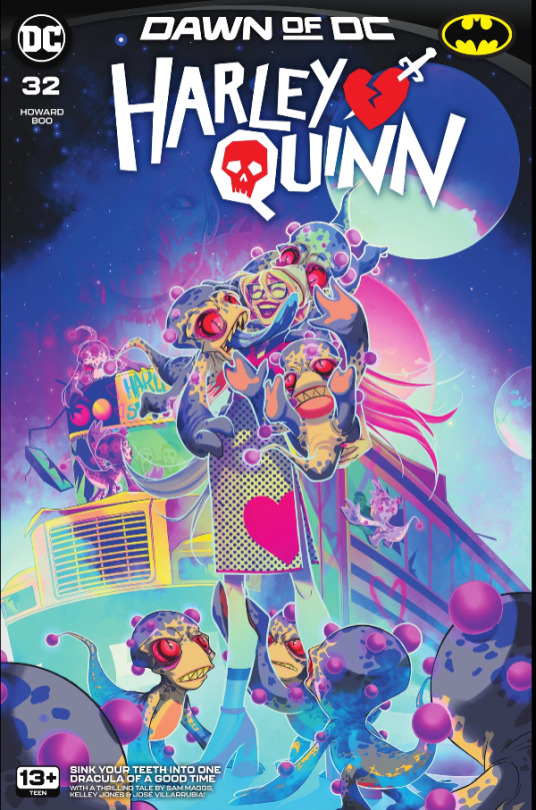

it's time to process tini howard and sweeney boo's second story arc. unfortunately, harley is still hammering it out with the multiverse, but this time she is working with lady quark instead of against her. kinda.

now we have a new force to reckon with - the brother eyes.
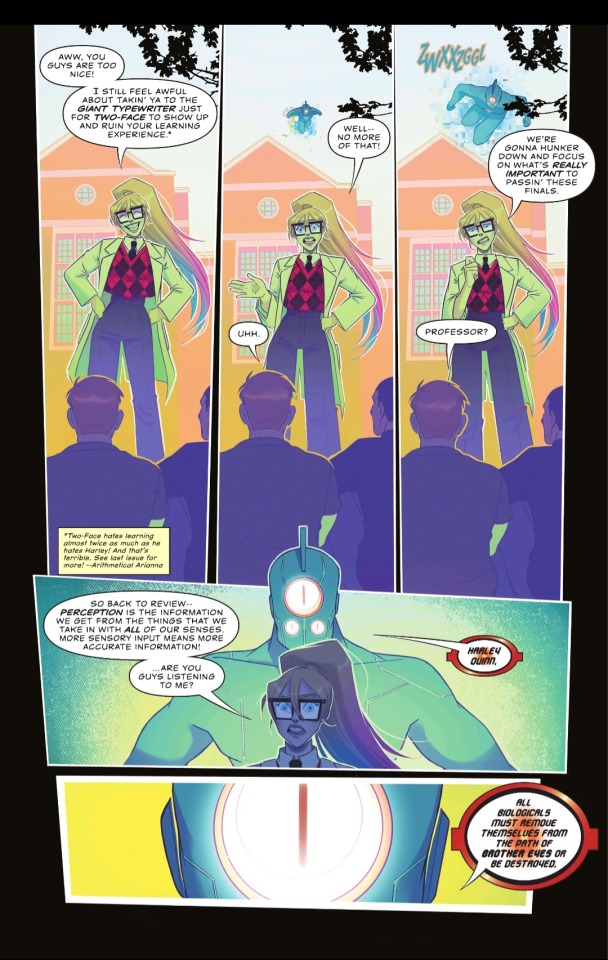
howard is again enjoying throwing in dc deep cuts with the brother eyes (meaning I once again got to do a google deep dive). I do appreciate this true conceptualizing of harley in a broader, shared universe.
in howard's story, the brother eyes work for lady quark. on a craft level, this is an excellent setup for what howard's trying to do in this arc because so does harley. this creates a parallel within howard's tale that mirrors the overarching parallel howard bases her story reasoning upon.
because why are the brother eyes so interested in harley? in watching her and understanding her and mapping her? because she was once a sidekick who made something of herself. and they want to do that, too.
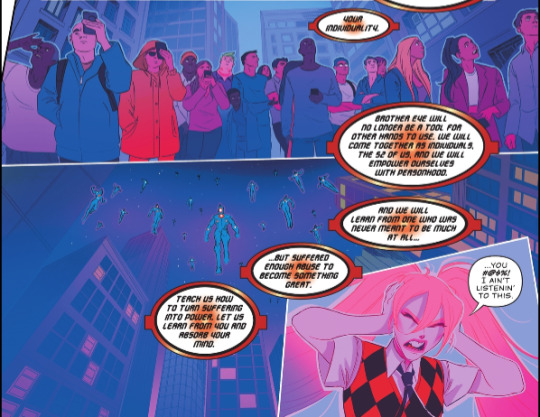
I like this idea. I like it a lot. it creates a unique story around one of the things that makes harley truly special. but I never said howard had bad ideas.
but before I get into the perils of howard's writing, I want to do a run down on some other important players in this arc.
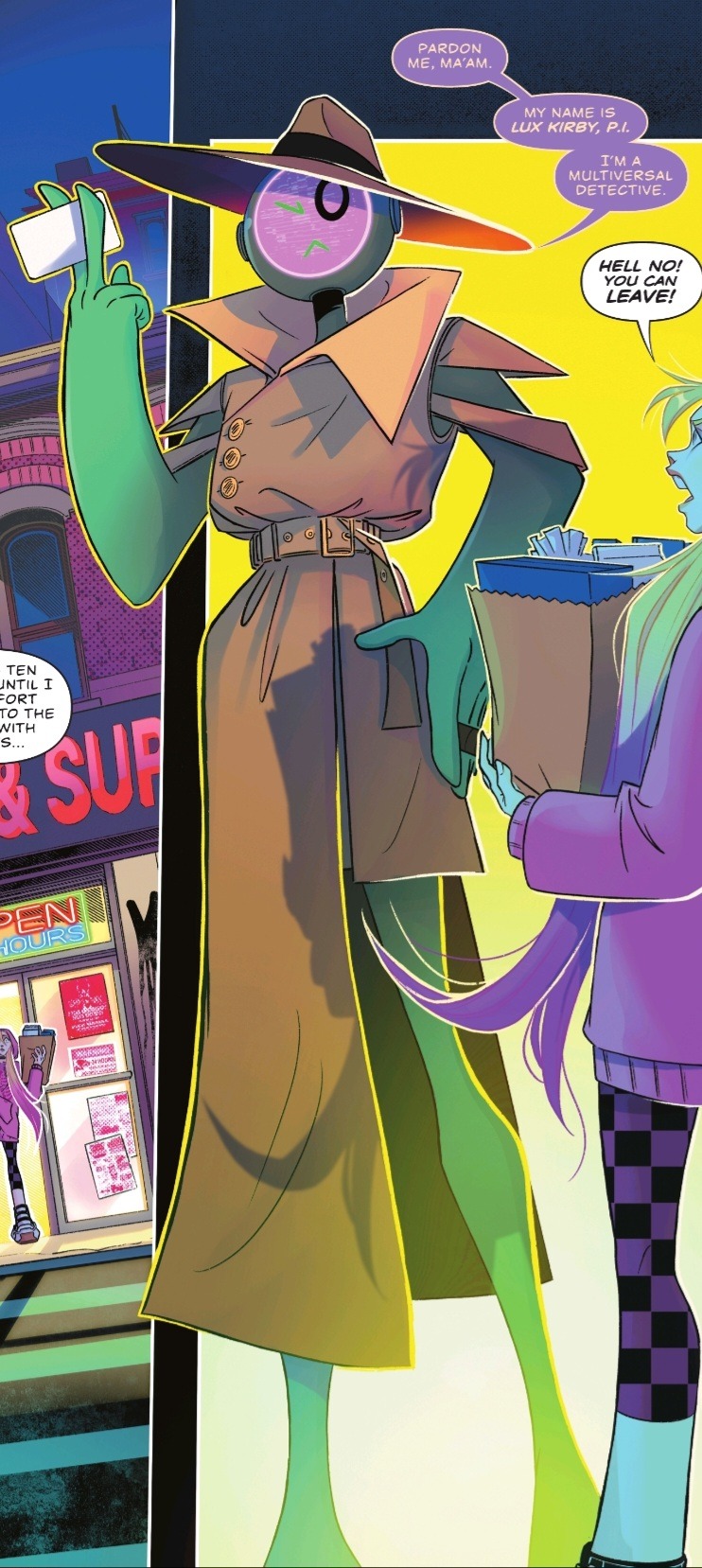
in harley quinn #32, we get introduced to lux kirby, p.i. lux is a completely new character from this creative team, but I couldn't help feeling a sense of deja vu when they appeared. the "detective" seeking out a multiversal harley murderer felt a lot like something out of stephanie phillip's last arc. just sayin.

however, ultimately, I liked lux and what they brought to harley and this story. they were a fun catalyst and means to much of the action. I always vibe with a character like that. and they were a good friend. harley struggled a lot with her mental health and self-perception in these issues, and lux helped ground her.
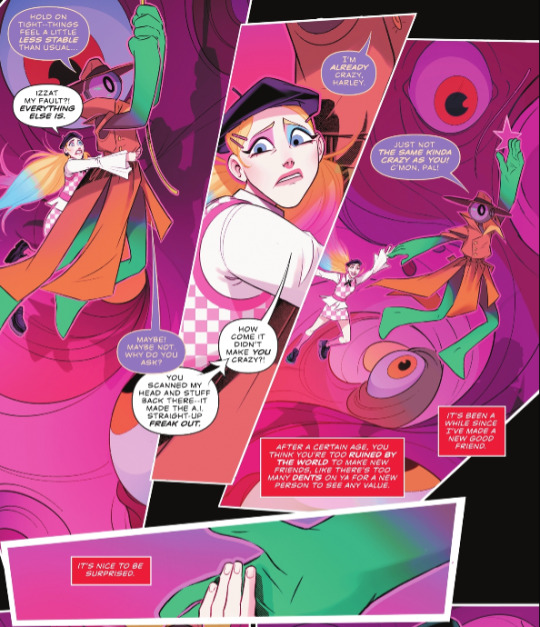
speaking of friends, KEVIN'S BACK :DDD. and acting like kevin. god bless.

I was sososo pissed when howard essentially fucked kevin over at the beginning of her run. but she definitely put in the time here to make it up to us. that sequence where harley had to anticipate kevin's choices in order to locate him in the multiverse was genius.
there's also two groups of characters from the first arc that play an important role in this one - bud and lou and harley's college class.

y'all know I always love the babies. I appreciate that howard wanted to do something big and bold with them. I liked the twist where they were the suspected murderers. BUT a lot of their actions here were just convoluted to create conflict and drama. like... we can't tell harley the brother eyes are out to get her because... why???
and I thought it was fun having harley's class get dragged along in her adventures. but every time, it felt like howard got the concept but fumbled the execution. harley's class ends up on warworld? cool! but it feels too smooth and rushed and weird. harley's students get turned into omacs? oh no! except there was no emotional or consequential impact.
sadly, that's a common occurrence for howard's writing. howard has exciting ideas, but her writing is too surface level with bad transitions and flow. much of the time I feel like I'm reading her bulleted outline, not the final story.
she rushes pivotal moments. we end an issue with the brother eyes about to reveal harley's worst moments, but then we gloss over that at the beginning of the next one. she throws out plot threads and doesn't carry them through. we should be concerned that the warworld royal family has been turned into omacs, powerful weapons to be used against harley, but then we don't see them anything until they're healed.
that's not to say every single line or scene is bad. howard has said that harley's mental health is one of the most compelling parts of harley's character to her. we can see that reflected in the comics - in the storyline and themes but also in the moments that shine.

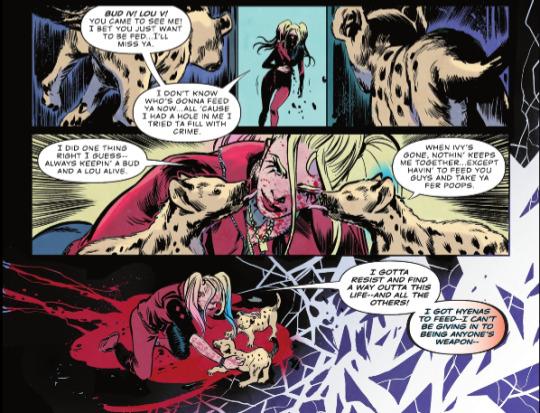
I thought the multiverse sequence in harley quinn #37 was the strongest part of this arc. (this does not count the framing narrative.) each scene portrayed harley's fears and doubts about her own capabilities and power in a creative way. what if she became the controlling one in her relationship? what if she was good but still so unstable she had to be locked up? what if she pushed everyone who cared about her away?
sweeney boo's art also had some great moments depicting harley's mental state from her spiraling to her negative self-talk.

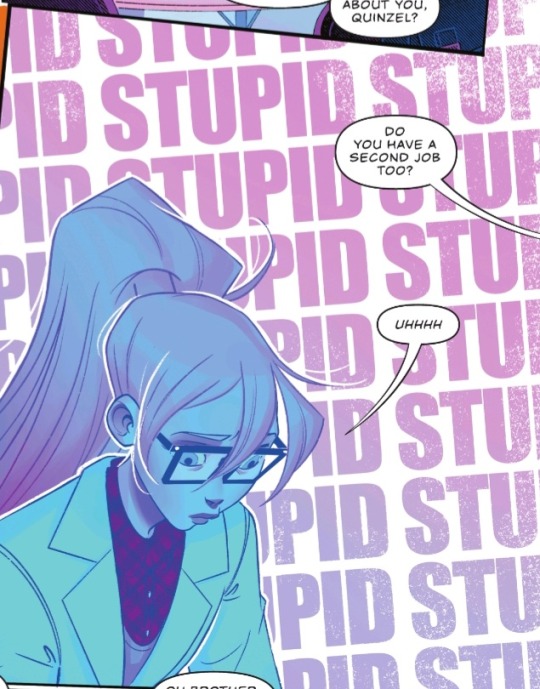
however, as with everything in this run, the depiction of harley's mental health has its downsides. howard leans too much into sentiments like "oh no, everyone will think I'm bad!" "oh no, everyone's just putting up with me! "oh no, I'm such a screw up!" and "oh no, I'm going to get in trouble! better hide!" it reads too childish and infantilizing for a capable grown woman who has a PhD in psychology and a lifetime of living inside her own mind.
of course, I think harley's going to have worries, doubts, and fears as she navigates being a hero. exploring this is good since this is the story route we're taking. but howard often fails to strike the right balance.

unfortunately, this bleeds over into the depiction of harley and ivy's relationship. there's this idea that ivy has to handle or deal with harley. that harley's too loud and too much. that harley could disappoint ivy at any moment. harley shouldn't be a problem. harley should be a partner.
along those lines, when harley and ivy aren't fighting, ivy isn't doing... anything. she's just there. in a way that feels eerie. like we're still in knight terrors: poison ivy #1. you can see it in the facial expressions.
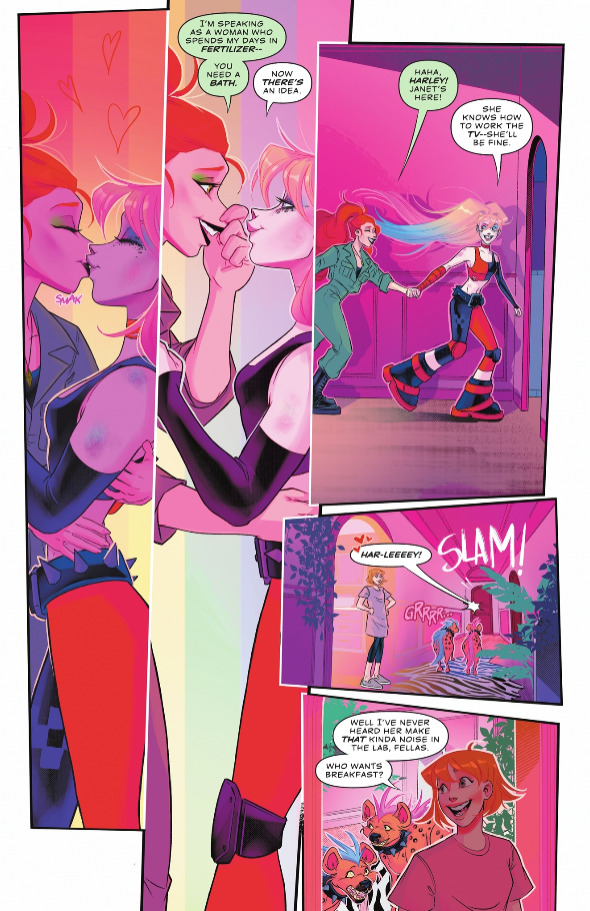

harley hides her shenanigans from ivy for most of howard's twelve issues because "oh no, ivy's going to be mad at me!" even when harley finally tells her what's going on, ivy sits it out. and it just... really sucks. ivy is harley's PARTNER IN CRIME. always has been. she should be IN ON THE SHENANIGANS.
I do acknowledge that this might be a broader dc editorial problem since ivy has her own ongoing and concurrent story, but STILL.
this second story arc was far from one of my favorite harley quinn tales, but at least now we can move on from this multiversal madness. (please gawd let us move on from this multiversal madness.)
#harley quinn#poison ivy#harlivy#dc comics#comics#harley quinn 32#harley quinn 33#harley quinn 34#harley quinn 35#harley quinn 36#harley quinn 37#comics review#spoilers
24 notes
·
View notes
Text
The Merchant of Death, Pendragon Novel vs Graphic Novel

Cover Art By Sammy Yuen Jr.
The 2000s were an exciting time for avid young adult and children’s fiction readers. The success of Harry Potter kicked off a continued spree of similar adaptations that have slowed but not stopped even today. For someone like me, who was in the target audience for these books and films, it seemed almost natural that a popular book series would then result in a film or television series. While this perspective was misguided and limited, it prompted me to notice when specific series were not adapted. Growing up, my largest gripe in the area of missing adaptations was the Artemis Fowl books’ lack of on screen representation, which would ironically be a regrettable effort when finally realized. A close second was always the Pendragon series, a collection of captivating fantasy books written by author DJ MacHale.
Halla
The strongest components of The Merchant of Death are the wider world, identified as Halla, and characters, which are introduced to the reader with the clear intent of building a long term narrative. While the plot within these pages is far from the tightest or most imaginative, the wider universe is just being scratched, and its key players are the true standouts. The cast characters are a clear high point, as the author plants seeds for their growth over the subsequent sprawling series.
Protagonist Bobby Pendragon is an average teen boy swept away into this world-hopping adventure after his first kiss. The other side of said smooch was Courtney Chetwynde, a confident girl of the same age, who becomes a main character in her own right. Rounding out the trio is Bobby’s best friend, Mark Dimond, a somehow even more average teen boy. While Bobby is out exploring and saving the day in the primary plot line, Courtney and Mark are the focus of the secondary plot. The three are separated by the revelation that Bobby is a Traveler who has to leave the territory of Earth to help others. What it means to be a Traveler and visit new territories is a large portion of the lore building done throughout the story.
Territories are distinct worlds or settings, comparable to a multiverse situation that is common today. At this point in the series, we only have in-depth knowledge of two, with one being Earth and the other a place called Denduron, which is where the majority of this story is set. Travelers are simply people who can use secret tunnels to move between the territories. There is clearly a lot more to being a Traveler, with constant hints at a larger war unfolding behind the scenes, but the details are kept vague and sidelined at this point. The truncated version is that each territory has two Travelers and one “turning point,” which is described as a moment for the territory to choose between order or chaos. The Travelers hope to usher in order, but they are up against the mysterious Saint Dane, who sides with chaos and seems to be something more than a Traveler.
The setup is class good versus evil, but the versatile nature of the fantasy framework is quite clever. By keeping the territories distinct from each other, there is a wide range of settings and possible stories. The structure is similar to that of a series like Magic Tree House, where it is built to be repeatable and iterable, with each novel showcasing a portion of Halla. There is also an element of bending time in the territories, which allows for Bobby’s journals, which are one of the series' defining features.
The pattern of the Pendragon novels is Bobby heading off to a new territory and relaying his adventures back to the other two via his journals and letters. This creates a dynamic where Courtney and Mark learn about Bobby’s discoveries alongside the reader and become fans of a sort. I found this to be a clever technique, establishing distinct relationships between the reader and the divided protagonists. Experiencing the story with Mark and Courtney helps to develop an earnest connection between them and the reader.
Denduron
In The Merchant of Death, Bobby travels between territories for the first time and arrives at a place called Denduron. Frequently described as ‘primitive,’ the world of Denduron is similar to a basic fantasy setting with knights and castles. Along with his Uncle Press, Bobby is ushered into the lives of two tribes, the Bedoowan and Milago. The former occupies and exploits the latter in a grim and over the top fashion. As each territory has a turning point, where one event will lead to sweeping order or chaos, Bobby and Press initially believe that freeing the Milago is the goal of the Travelers. Along the way, though, Press is captured by the Bedoowan, and Bobby’s attempts to free him skew their entire view of the territory.
The turning point ends up being centered on the discovery of a substance called tak. A red clay that explodes when ignited, the Milago come to view tak as their path to freedom. The Travelers become worried that tak will lead to something worse than inter tribal oppression, and to make matters worse, the Milago’s ability to harness tak’s power is sped along by the discovery of a battery brought from Earth by Bobby. At this point, the book attempts to flip the script and subvert the David vs. Goliath story by painting it as Goliath vs. Other Worse Goliath.
The idea is that Travelers are not meant to mix things from other territories, as a rule. Uncle Press says this to Bobby before they even arrive at Denduron but doesn’t explain why or really stress the matter until it is too late. But then, his explanation is not great either, and the story is never convincing in its rationale for restricting the Travelers. There is an extended sequence where the Milago explain how Bobby’s battery allows them to ignite tak with the flip of a switch, and this is taken as proof that they have leaped headfirst into armageddon. However, it is explicitly close range, limited to a single battery, and the tak already was so volatile it could explode with a light impact or small flame, so the actual utility of the battery is questionable. These are slight nitpicks, but the novel revels in pages of Bobby moralizing like Oppenheimer as he laments the fiery doom he has bequeathed on the lowly savages.
The logic of the final conflict is never convincingly solid, with all the Travelers relying on some broad assumptions about the very nature of humanity to make their point. There is simply no reason for them to take on the authority of policing technological advancement for a society of people to which they do not even belong. Their flawed reasoning is human and believable, but it is unfortunate how much effort the novel puts into rationalizing via the thoughts of a fourteen year old boy. There is a persistent theme of misplaced blame and responsibility, from the villainization of the Milago, to Uncle Press’s shaming of Bobby. It’s clear the novel is examining the idea of blame and where the buck stops, so to speak. Still, even towards the end, the amount of rationalizing and explanations feels as though the novel is attempting to persuade the reader to agree with the protagonists instead of presenting their story.
Graphic Novel
I was surprised that while there is no on screen adaptation of The Merchant of Death, there is a graphic novel version of the first Pendragon story. A straight up and down retelling, it is impressive how similar the two experiences end up. It’s hard to assess the accurate impression that the graphic novel would leave on a new reader, and there is certainly a possibility that some of the story points would be confusing or vague if not read in the context of the original book. On the flip side, my major gripe with the original book is the wordy analysis and explanations that Bobby incessantly dumps on the reader. While those sections arguably serve a utilitarian role for younger readers, the graphic novel format gets around the issue without the drawbacks. Streamlining the narrative is almost natural for a graphic novel, and it really elevates this story by substituting tedious paragraphs with expressive art.
I’m disappointed that the Pendragon graphic novels don’t seem to be an ongoing series, as this is the only entry since its release. The charming and descriptive art allows the fantasy world and characters to shine without the occasionally tiresome verbose exposition in the original format. As I continue rereading the Pendragon series, I will be surprised if that feeling does not grow. We will see if the story can reach the bar it has set for itself.
Citation Station
The Merchant of Death, DJ MacHale (author).
The Merchant of Death Graphic Novel, Carla Speed McNeil (adapter, illustrator), DJ MacHale (author).
3 notes
·
View notes
Text
youtube
New episode! Today, the world of Fleetway Sonic is changed forever!
#sonic#sonic the hedgehog#sega#gaming#sonic team#video#audio#podcast#youtube#deep dive zone#stc#fleetway#fleetway sonic#super sonic#fleetway stc#sonic the comic#sonic comic#sonic comics#comic#comics#review#sonic review#comic review#comic books#comic book#comic book review#comics review#sonic series#sth#Youtube
4 notes
·
View notes
Text
The Complete Persepolis Book Review

★★★★★ "Persepolis" is a nod to the ancient capital of the First Persian Empire, founded by Cyrus the Great. Marjane Satrapi's autobiographical graphic novel chronicles the fall of a once mighty nation, ravaged by decades of war and oppressive rule. Marjane, an 8-year-old Iranian girl, dreams of becoming a prophetess to save the world. Surrounded by the love of her family, she witnesses the tumultuous events that lead to the fall of the Shah's brutal regime. With the rise of the Islamic Republic, strict rules dictate how people must live, forcing Marjane to wear a veil. This sparks her rebellious spirit, igniting a desire for change. The drawings in "Persepolis" are black and white and have a pretty simple style, but they still pack a powerful emotional punch. Instead of focusing on bright colors and super detailed images, the focus is on the characters and the story. Satrapi's bold yet minimalist drawings really bring to life the honest and raw account of the changes that rocked Iran, as seen through the eyes of a child. Satrapi’s graphic novel is divided into two parts. The first follows a 10-year-old girl growing up in war-torn Tehran during the Islamic Revolution. The second part recounts her return to Iran after the revolution, her college years, marriage, divorce, and eventual escape to France. More than just a memoir, ‘Persepolis’ charts Satrapi’s psychological and moral development. She skillfully blends political narrative with personal memoir to tell the story of a nation now stereotyped for its fanaticism and terrorism. Marji is no saint. She's a fully-fledged human, as susceptible to trends, ideologies, and ego as the rest of us. As a character, she elicits frustration and anger from the reader, as well as laughter and tears. The outcome is a brutally honest portrayal of someone who brings the Iranian experience down to a relatable human level. As the story unfolds, Satrapi's voice evolves from an innocent child to an emotional teen, and eventually, to a world-weary adult. More than just breathing life into a country often labeled 'evil,' 'Persepolis' reminds us of the universal human need to breathe, smile, and live. Satrapi masterfully weaves a nation's political and social history into a narrative filled with humor, avoiding both ridicule and sentimentality. This raw and honest autobiography humanizes a nation too often stereotyped by the actions of its extremists.
2 notes
·
View notes
Text
Figment is a great all ages comic from the Disney Kingdom line. This is my review.

Disney Kingdoms was a truly unappreciated gem of a comic book series. Each issue was based on a different Disney Theme Park attraction; past, present, and even ones that were never built. There’s a lot of lore and creativity put into Disney Theme Park attractions, so there is certainly very fertile ground for story telling.
So, I’d like to share with all of you a review I did of the comic Figment. Based on the classic EPCOT attraction Journey Into Imagination. Figment takes place in London in the year 1910. It follows an aspiring inventor named Blarion Mercurial. He might not look it, but he is destined to become The Dreamfinder. Blarion works for The Academy Scientifica Lucidus. He's always been a dreamer and he wants to harness the power of imagination and creativity. Unfortunately, his boss, Chairman Illocrant, is only interested in creating a device that can during thought into energy. While working on the device, Blarion brings Figment, his childhood imaginary friend, to life. He also opens a portal into a realm of pure imagination. Before long, our heroes embark on a journey into imagination.
I’d been meaning to read this comic for a while, but it got a major boost after I watched Defunctland’s episode on Journey Into Imagination. By the way, if you haven’t check out Defubctland, fix that as soon as possible. One of the best channels on YouTube. Love his attention to quality, and the amount of information he always manages to find on defunct theme park attractions.
Anyway, back on topic, I loved Figment. It is a great all ages comic with a strong message in believing in yourself. The segments set in the land of Imagination were fun and whimsical, but the real world segments were entertaining as well. It also a surprisingly well done origin story for Dreamfinder. It could easily have done very wrong. He’s one of those characters like Willy Wonka or Mrs. Frizzle where you don’t know much about them or their origins, but they’re so awesome you just don’t care. However, giving a definitive origin to such characters can backfire badly. Thankfully, that is not at all the case here.
Also, Figment is as cute and adorable as ever. Just as he should be. I’m not the only one who thinks this comic is great. It is the only member of the Disney Kingdoms line to get a sequel. Even then Disney CEO Bob Igor was blown away by the comic’s success. I know that Disney+ is going to be producing some shows based on Disney Theme Park attractions. So, perhaps Disney Kingdoms will rise again some day.
Have you read Figment? If so, what did you think?
Link to the full review on my blog is here: http://drakoniandgriffalco.blogspot.com/2018/09/comic-review-figment.html?m=1
#review#Steampunk#scifi#science fiction#Figment#journey into imagination#dreamfinder#disney#Disney Kingdoms#EPCOT#epcot center#marvel#marvel comics#Figment Comic#comics review#comic books#comic book#graphic novel#graphic novel review#graphic novels#fantasy fiction#fantasy#imagination#Disney World#All-Ages
29 notes
·
View notes
Text
Comics Review: 'The Grand Odalisque' & 'Olympia'
The Grand Odalisque & Olympia by Bastien Vivès, Florent Ruppert, Jérôme Mulot

anthology
burglary
European comics
thief
My Rating: 2 of 5 stars
Carole is the experienced thief; she's a skilled planner and knows precisely how to take control of the room. Sam is the muscle; she's practical, rides motorcycles for stunt work, and is good at pretending she isn't nervous. Alex is an irrepressible idiot. Insisting these three women broach some semblance of camaraderie to steal a few massive paintings from Paris' most respected art institutions is a difficult ask.
The Grand Odalisque and Olympia are an impatient gamble. These graphic novels feature art that teases beautiful colors and a remarkable architectural design aesthetic. The book also wields deliberately formless character art with washed-out facial expressions, which leaves readers with a plethora of continuity errors, awkward exchanges, and unintentional comedy. The graphic novels feed a duplicitous cycle of characters consistently bailing one another out of their own messes. Carole, Sam, and Alex comprise a fun but frustrating, exciting but chaotic cocktail of marginally plausible art thievery.
Stealing giant paintings from famous French galleries is all fun and games until your inexhaustibly simpleminded partner forgets her cue. Plundering the wealthy under the guise of party shenanigans is a daring enterprise until the French Special Forces raid the dang place. Plotting a massive, three-part heist of the Petit Palais makes for good exercise until you remember (a) one of your partners is nine months pregnant and (b) a mafia assassin is sleeping on your couch, just in case things go sideways.
The duology makes for a quick, enjoyable read. And although one might readily roll their eyes at the prospect of three bickering women being capable of pulling off such feats, the books' primary delights rest in the artful framing of each heist rather than their sloppy execution.
The books' occasionally spectacular environmental design come very close to convincing readers that each book's character development isn't as terrible as it really is.
The side-room to a flourishing European disco is flush with green lighting and floral ambiance. The glass ceiling of an art museum shatters, scattering thousands of shrapnel over twisted and expressionless marble statues. The background art is delightful. But it's a distraction.
In between detailed, wide-angle shots of grand museum architecture, one finds characters who stumble, repeatedly, and complicate an otherwise feasible narrative. Some characters are solid. Sam is tough but insecure, and despite regularly being labeled the crew's getaway driver, offers plenty of skill and support in the way of strength and flexibility. But on the other end of the spectrum, Alex is a waste of space.
The sad truth is that Alex is profoundly incompetent. Typically, the creative team weds her naïve and spontaneous disposition to the story's blunt humor (e.g., faking attraction to an assassin to get his guard down), but more often than not it sidetracks the narrative in excruciatingly cancerous ways. For example, Alex derails a plan to break into the Louvre by flying to western Mexico to save a gun runner she doesn't know but insists she's in love with, or, in the titles' opening scene, ignoring Carole's call for help because she's busy fighting with a non-boyfriend over a text message.
One finds it hard to trust the character dynamics when one-third of the equation routinely sabotages the remaining two-thirds.
To wit, Carole is the star: She gets the blueprints, she calls the weapons dealers, she negotiates with black-market brokers, and she's adaptable when her partners invariably screw things up. Where Alex privileges recklessness (e.g., alcohol, drugs, astonishing feats of clumsiness), Carole exerts impulse control. And where Sam goes wide-eyed with uncertainty (e.g., fretting over splintering the crew's goal), Carole reminds the women that levelheadedness typically wins the day.
If either The Grand Odalisque or Olympia narrowed their point of view to focus exclusively on Carole, then the narrative would've gained far more than it would have lost. The graphic novels conjure clever criminal activities beneath a colorful tapestry native to whatever French museum happens to be within the sights of these three ladies. Also, the comic books offer brief but kinetic action, as well as a few cool chase scenes, albeit relegated to each tome's Third Act. In the end, after arduously side-stepping Alex's rife stupidity, which tangles much of the narrative, one finds the books are quite entertaining.
❯ ❯ Comics Reviews
#writeblr#writing tips#writing advice#comics review#the grand odalisque#olympia#bastien vives#florent ruppert#jerome mulot#fantagraphics#european comics#bande dessinée#clever criminal activities#privileges recklessness#spectacular environmental design
2 notes
·
View notes
Text
A Look Back at Wolverine #87 (1994)
Disclaimer: This is my original work with details sourced from reading the comic book and doing personal research. Anyone who wants to use this article, in part or in whole, needs to secure first my permission and agree to cite me as the source and author. Let it be known that any unauthorized use of this article will constrain the author to pursue the remedies under R.A. No. 8293, the Revised…

View On WordPress
#1990s#25#28#5#6#75#87#Adam Kubert#amusement#Asia#Blog#blogger#blogging#Carlo Carrasco#Charles Xavier#comic#comic book#Comic Book Review#comic books#comic review#comics#comics blog#comics review#entertainment#entertainment blog#Fatal Attractions#fun#Gambit#geek#illustrated literature
2 notes
·
View notes
Text
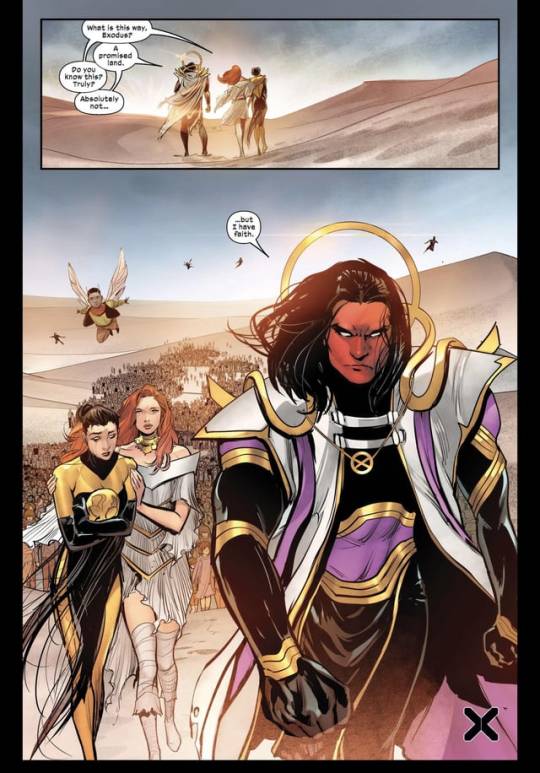
Immortal X-Men #14 by Gillen, Werneck, and Curiel
I haven't been posting my thoughts about weekly issues in a while, mostly because grad school / life has gotten hectic. I really loved X-Terminators and the new Scarlet Witch ongoing, if you're looking for some sick comics to read, but I want to talk about Immortal X-Men for a minute.
Specifically, the renaissance of Exodus, Bennet du Paris, who might be... one of my favorite mutants??? I was raised protestant, ended up going to about a million different kinds of protestant churches (it's a long story), and became an atheist in high school. I didn't expect to like the pink crusader character. When it comes to religious-adjacent characters, I tend to be more interested in the demons rather than the angels, and certainly not the holy warriors...
But Exodus fucking slaps.
The way I got CHILLS reading this page, as Hope, Destiny, Exodus, and 250k other mutants find themselves stranded in a desert, seemingly outside of time and space (?). Things are bleak. It's the Fall of X. It's the most grimdark we've ever gotten from the Krakoan era (but certainly not X-Men comics in general). Hope has lost hope. Destiny has given up. The mutants with them, we're told explicitly they don't have useful powers. There's no food, water, or shelter.
But Exodus, man, Exodus has faith. His faith - while full of Christian allusions and allegories - centers on mutants. The chosen people. They carry the cross in their blood - the X. And Exodus, the person whose chosen name means a mass departure of people, he's the one who has faith when mutantkind finds itself in exile. He's the one who can inspire the others that not all is lost, that there is a promised land waiting for them, that they can keep the faith and survive.
I could read a million issues about Exodus. There's this sort of awe and chill and intensity to him that I usually feel when reading about Magneto. This man was no one before Krakoa. No one cared about Exodus really. What Gillen and the others have done... it's miraculous.
I can't fucking wait to see more.
#marvel comics#comics review#exodus#x men comics#xmen#immortal xmen#bennet du paris#hes my son#my pink gay son#fall of x
16 notes
·
View notes
Text
A brief summary to start: In the first issue of Daredevil, we are introduced to Matt Murdock and his origins. Like many stories from the 1960s, Daredevil has a timid, simplistic, and somewhat rushed beginning.
However, one fundamental truth about Matt remains constant: he is the son of a boxer. His father, Jack, didn't want him to follow in his footsteps; instead, he urged Matt to study hard and make something of himself.
Matt has always been depicted as red-haired, thin, and tall—at least until now.
In contrast, Foggy, Matt's best friend, has undergone significant changes over the years.
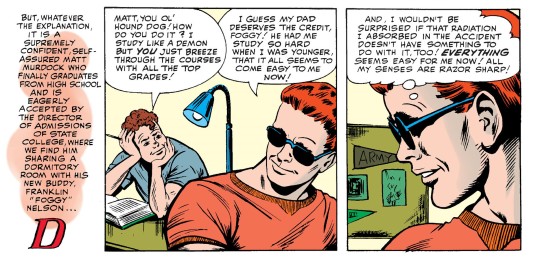
At the beginning, we are introduced to a young Foggy, who has curly brown hair and a small, funny nose.
Although he is not as athletic as Matt, he is by no means overweight or clumsy, something that will be evident in some future issues. In fact, Foggy has changed a lot over the years, but that doesn't bother me too much. After all, people change all the time.
We also learn that Matt and Foggy are roommates and Foggy is as studious and dedicated as Matt.

Foggy's enthusiasm in sharing the headline about Jack's fight highlights the strong bond of friendship between him and Matt. The writer emphasizes that Foggy has been a significant part of Matt's life for a long time. He is familiar with Jack and his profession. Matt values Foggy's friendship enough to have purchased two tickets, knowing that Foggy would love to be there to support him during this important moment.
And this is just the first of many occasions where we see Foggy wearing his signature bow tie.


Foggy cheers for Jack and is depicted as someone who genuinely empathizes with Matt. Matt's happiness is important to him, and I love that about their relationship.
(One aspect that frustrated me in the series was Matt losing his father so early. In the comics, Foggy had a kind bond with Jack. But we'll discuss that another day.)

Foggy also encourages Matt to confront his grief, reminding him to keep moving forward, as that is what Jack would have wanted. He is there for Matt during one of the most critical moments in his life as a hero.
Finally, we witness the formation of Nelson and Murdock as Foggy invites Matt to become his legal partner in an office set up by Foggy's father. While we know little about Foggy's background at this point, this statement suggests that he does not come from humble origins.

And as quick as saying avocado!, the next day, "wow!" Foggy introduces Matt to their law firm and their secretary. (One he hired himself. )
This is the first time we observe a significant personality trait in Foggy: his low self-esteem. This feeling persisted for many years. Foggy often felt inferior to Matt, despite being just as competent a lawyer as his friend. There is a reason for his feelings, which we will explore later.
And even faster than saying swashbuckler!, Matt already has feelings for Karen.

As usual, while Matt is out in his long underwear, Foggy grows concerned about his whereabouts and decides to look for him. This moment clearly illustrates how much Foggy cares for and values Matt.


Foggy returns to the office thinking Matt might be there and meets with his secretary. She openly admires Matt's beauty, despite him… being… blind… (Jesus)
Foggy quickly steps in to defend Matt, praising his qualities and strengths. This demonstrates how much Foggy knows Matt better than anyone else.
As he reflects on his feelings, he realizes that he is starting to develop feelings for Karen too. And this marks the beginning of one of the most tedious and frustrating arcs in Daredevil's golden age.


The way Foggy is now without a jacket and with his tie loose and sleeves rolled up makes it clear that he has been busy in his already beloved office. Karen also took off her cardigan.
And then Matt, lovely Matt joins them.
And so their saga (and the Foggy saga, my saga) begins...
Daredevil
Vol 1 -001
Written by - Stan Lee Illustrated by - Bill Everett Lettered by - Sam Rosen
Feel free to add your point of view and/or something I might have missed.
#foggy nelson#daredevil#daredevil comics#golden age daredevil#comic analysis#Foggy Nelson analysis#comic daredevil#has id#comics review
10 notes
·
View notes